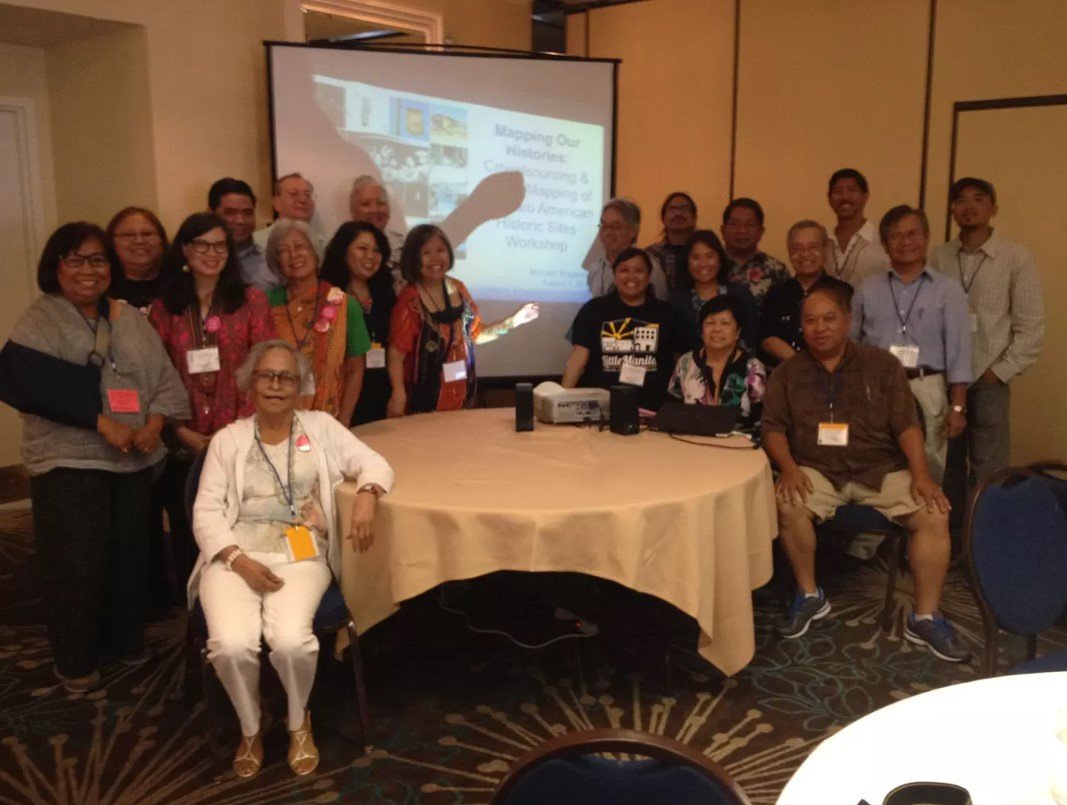HistoryPin is project of Shift Collective, a partner organization that supports and designs community-driven initiatives to boost social, cultural and resource equity. “East at Main Street” is a collection within HistoryPin lead by APIAHiP, since 2014.
This collection gathers photographs, videos, memories, and other materials related to places that are important to Asian and Pacific Islander American communities. Sites associated with our collective and diasporic history and cultures have been underrepresented and disproportionately recognized through traditional historic and cultural designations at the local, state, and national registers. Raising awareness of these places will assist in their preservation and help create a more complete picture of our presence and contributions in America’s past, present, and future.
National Park Service: Asian Pacific Islander Historic Mapping Project
Final Report: December 31, 2014 ↓
-
[text from nps.gov, last updated: July 8, 2021]
"East at Main Street: APIA Mapping Project" (formerly named "Asian Pacific Islander Historic Sites Map") raises awareness of Asian and Pacific Islander American (APIA) historic sites and helps conserve cultural resources associated with Asian and Pacific Islander Americans by utilizing new technologies and engaging a broad audience across the United States.Developed in collaboration with the location-driven web platform,Historypin, "East at Main Street" resulted in new information about places that matter to APIAs and can be used to develop landmark designations, interpretive and educational projects, public programs, travel itineraries and more. Raising awareness of these places will assist their preservation for the future.
"East at Main Street" gathers photographs, videos, memories, and other material related to places that are important to APIA communities. Few sites associated with APIA history and cultures have been recognized as landmarks. Raising awareness of these places will assist their preservation for the future and help create a more complete picture of United States history.
This project engages community members, organizations, archives, and librariesas "East at Main Street" allows individuals and organizations to post historic and contemporary photos, video and text that will be accessible on computers and as a mobile smart phone app. They can add content and share their own memories, images, and related items associated with important places for APIA on the East at Main Street map.
Community workshops were held in 7 locations to train individuals and organizations so that they can encourage their constituents to add to "East at Main Street". The project had 18 community partners assist in planning, marketing, and conducting these community workshops. In addition, presentations at national conferences and guest lectureships were conducted.
This project uses new technologies, APIAHiP's existing national network, andnew partnerships to reach Asian Pacific Islander communities across the U.S. Some key results from this project include new information about places that matter to APIAs and can be used to develop landmark designations, interpretive projects, public programs, travel itineraries and more. Additionally, we expect the project to result in a strengthened network of APIA preservationists. Our success is measured by the number and range of sites contributed as well as the reach of people and organizations that contribute. We expect the project's findings to help shape the National Park Service's Theme Study by identifying key historic sites and resources and will be looking for ways to capture that impact.
-
For many historic sites and resources in APIA communities in the US, the connection between a building and its significance to APIA heritage has been hard to find. So, identifying these places, documenting their history, and making decisions about how to protect them is an important way to ensure that the history of APIAs is not entirely lost but remembered, reclaimed, and preserved. Efforts are underway by the National Park Service to identify additional properties that may be eligible for listing on the National Register of Historic Places as well as properties that might have the potential for National Historic Landmark designation.
"East at Main Street: APIA Mapping" facilitates communication about historic/cultural sites that matter in the Asian and Pacific Islander American community and allows people to share information and resources in documenting and preserving these sites. "East at Main Street" aims to raise awareness of places associated with APIA heritage to assist in preservation for the future and to help create a more complete picture of United States history through community engagement and participation.
With fiscal sponsorship by Asian Americans Advancing Justice (formerly Korematsu Institute and Asian Law Caucus) and collaboration with HistoryPin, APIAHiP developed and launched a location-based community driven website, "East at MainStreet: APIA Mapping Project" to collect content about API historic sites from individuals and organizations that is accessible online and as a mobile smart phone app. It is an interactive and community-based project where people can add content and share their own memories of locations (via "pinning") on "East at Main Street". These "pins" are also as a gallery of historic places and an interactive map. Each pin (e.g., historic photograph, video, historic document, audio) is "pinned" to a geographic location (e.g., address, street interaction). Customized tours and collections (slideshows) have been created to highlight specific themes, such as Filipino American sites, or historic resources associated with religious traditions.
-
Project Site Development
In collaboration with HistoryPin, APIAHiP developed and launched a location-based community driven website, "East at Main Street: APIA Mapping Project" to collect content about API historic sites from individuals and organizations that is accessible online and as a mobile smart phone app. The project site was developed to be user friendly for various types of groups (e.g., older adults, youth) with online video tutorials.
Project Launch and Marketing
The website was launched in April of 2014 with a press release disseminated to Asian American media, APIAHiP members (via website, listserve, blog), and social media (e.g., Facebook, Twitter).
Community Workshops and Presentations
In collaboration with community groups, non-profit organizations, archives and individuals, the project gathered materials (photographs, old newspapers, etc.) and stories (oral histories or talk story, written narratives, etc.) to capture the rich layers of place making and community-building in historically and culturally significant sites throughout the United States and US te1ritories.Community workshops, online webinars and training videos, and presentations at national conferences and universities were conducted by the project co-directors. We also had the opportunity to work with youth through two Youth Heritage Projects in San Francisco and Seattle that were partnerships between local heritage organizations and the National Park Service.
-
Community Workshops (100 participants in 8 locations)
Boston, MA
Los Angeles, CA
Philadelphia, PA
Riverside, CA
San Diego, CA
Stockton, CA
Seattle, WA
San Francisco, CA
Community Partners
1882 Foundation
Asian Arts Initiative
Austin History Center
Boston Chinatown Neighborhood Center
Chinese American Historic Society of Southern California
Chinese Historical Society of New England
Filipino American National Historical Society - Philadelphia chapter
Little Manila Foundation
Little Tokyo Historical Society
Little Tokyo Service Center
My Historic Filipinotown
National Parks Conservation Association - Los Angeles office
National Parks Service - Pacific West Regional Office
Riverside Metropolitan Museum
San Francisco Heritage
Save Our Chinatown - Riverside Committee
Smithsonian Center for Folklife and Cultural Heritage
Smithsonian Asian Pacific American Center
UMass Boston Asian American Studies
University of the Pacific Benerd School of Education
Washington Trust for Historic Preservation
Wing Luke Museum
Conferences/Guest Speakers
California Preservation Foundation Annual Conference
CUNY Asian American/Asian Research Institute's Annual Conference (New York, NY)
Filipino American National Historical Society Conference (San Diego, CA)
National Asian and Pacific Islander Americans Historic Preservation Forum (Washington, DC)
National Council on Public History Annual Conference (Monterey, CA)
National Trust for Historic Preservation Annual Conference (Indianapolis, IN)
Savannah College of Ali and Design - School of Building Arts
Online Presence
Project website
Webinars
Facebook
Twitter
APIAHiP Website
East at Main Street blog
Other Forms of Marketing
Press releases
Flyers
-
Website Development
Several potential methods for creating a crowd-sourced map of historic resources were explored and ultimately, we decided that Historypin offered the best functionality and accessibility at a reasonable cost. "Pinned" sites can be explored on Historypin through historic and contemporary photos, text, video, and mapping. Users are able to employ the location and date of an image to "pin" it to Google Maps. Where Google Street View is available, users can overlay the historical photograph and compare it with the contemporary location.
Public/Community Engagement
We have developed a community engagement plan with outreach to our existing network, webinars co-facilitated by NPS, and commitment by a number of partners to share information about the mapping project with their constituents. Seven community workshops were held to build interest and enthusiasm for the project and train people in how to share this tool with their communities will help expand the reach and impact of the project substantially. The workshops were hosted by local APIA community groups and provided information on how to contribute material to the mapping project and how to teach others to participate.
Discussion
By raising awareness of Asian Pacific Islander American historic sites, this project will help conserve cultural resources associated with under-represented communities and the "recent past." The community workshops engaged local community organizations and individuals to think about how individual "pins" of impo1iant sites can make a larger impact in the representation and preservation of historic sites and resources. The online efforts reached out to and engaged community groups and individuals in hard-to-reach regions and for those that may not consider themselves doing historic preservation work. Lastly, "East at Main Street" brought attention to the issues and needs of preservation in APIA communities to a national level through the conference presentations and lectures.
-
This project has facilitated dialogue and interest about historic/cultural sites that matter for Asian and Pacific Islander Americans, and allowed individuals and organizations interested in historic preservation work to share information and resources on historic sites and resources.
This project uses new technologies, APIAHiP's existing national network, and new partnerships to reach Asian Pacific Islander communities across the U.S. Some key results from this project include new info1mation about places that matter to Asian Pacific Islander Americans and can be used to develop landmark designations, interpretive projects, public programs, travel itineraries and more. Additionally, we expect the project to result in a strengthened network of APIA preservationists. Our success is measured by the number and range of sites contributed as well as the reach of people and organizations that contribute. We expect the project's findings to help shape the National Park Service's Theme Study by identifying key historic sites and resources and will be looking for ways to capture that impact.
-
We are grateful for the funding support from the National Center for Preservation Technology and Training.
We would like to acknowledge and thank our project partners, HistoryPin and Asian Americans Advancing Justice (formerly Korematsu Institute/Asian Law Caucus) for their time, talent, and support.
We would like to thank our partnering organizations and participating individuals/organizations for contributing to the "East at Main Street: APIA Mapping Project":
Chinese American Historic Society of Southern California
Chinese Historical Society of New England
Filipino American National Historical Society - Philadelphia chapter
Little Tokyo Historical Society
My Historic Filipinotown (MyHiFi)
National Park Conservation Association - Los Angeles office
National Park Service - Pacific West Regional Office
Save Our Chinatown - Riverside Committee
Smithsonian Center for Folklife and Cultural Heritage
Smithsonian Asian Pacific American Center
Open in new window/optimized for mobile:





